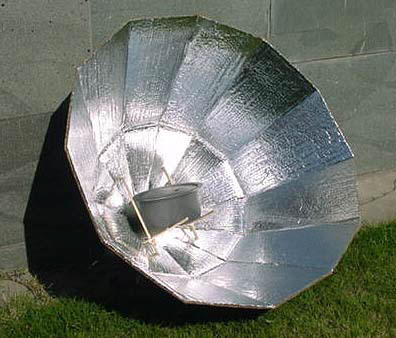Double-Angled-Twelve-Sided (DATS) Solar Cooker (en español aquí)
(Editor's note: SCI has not tested this cooker for safety, effectiveness, stability, or ease of use)
by Teong H. Tan
 I was introduced to the world of solar cooking in 1982 when, as a student, I
was working on a heat-transfer experiment at the Brace Research Institute in
Montreal. Brace had shortly before that experimented with and tested a variety
of solar cookers. Many years had passed by for me without any further solar
cooking exposure until I discovered Solar Cookers International’s web site three
years ago. The site has since become the place where I catch up on solar cooking
activities.
I was introduced to the world of solar cooking in 1982 when, as a student, I
was working on a heat-transfer experiment at the Brace Research Institute in
Montreal. Brace had shortly before that experimented with and tested a variety
of solar cookers. Many years had passed by for me without any further solar
cooking exposure until I discovered Solar Cookers International’s web site three
years ago. The site has since become the place where I catch up on solar cooking
activities.
Background
The “CooKit” is one of my favorite solar cookers. After reading about difficulties many people face locating heat-resistant bags, and experiencing how ordinary plastic bags melt on contact with hot cooking pots, I started to explore the possibility of a simple, low cost, easy to construct cooker that requires no plastic bag. I have designed one that I call Double-Angled-Twelve-Sided (DATS) solar cooker. It seems to do the job on clear, sunny days.
DATS cooker employs 24 small reflective panels to concentrate extra sunlight to compensate for the heat loss from not using a plastic bag. DATS cooker design is similar to a deep-focus parabolic cooker, but instead of using a true parabolic curve, multiple flat panels concentrate sunlight onto the cooking pot. Two reflective surface-angles, 45º and 60º, are used so that a bend can be introduced in between for structural rigidity to hold the cooker’s shape. This structural rigidity allows for DATS cooker to be constructed out of cardboard material.
A DATS cooker, tested in Shanghai, reached a maximum temperature of 140ºC (284ºF) inside an empty black cooking pot, on a clear sunny day with 21ºC (70ºF) ambient air temperature and a slight breeze. Eggs became hard-boiled in 30 minutes and two cups of rice cooked in 95 minutes. The cooker should be re-positioned every 45 minutes or less for better efficiency.
A simple supporting structure, made out of bamboo or wooden sticks, is built-in as an integral part of DATS cooker to support the cooking pot at the desired cooking position.
DATS cooker is held rigid by a string, which links all twelve 45º-panels together at the bottom end. The string is made taut by twisting in the loose string loop around a short stick. The tighter the string is, the better DATS cooker holds its shape. If needed, a small gage string, tied across two opposite panels, at 3:00 o’clock and 9:00 o’clock position, can be used to pull in any slack in the cooker shape due to gravity. By loosening the string and removing the cooking pot supporting structure, DATS cooker can be folded up for storage or transportation.
Required materials are cardboard, aluminum foil, white glue, paper tape, small bamboo/wooden sticks, and string.
Construction
Cut 12 rectangular pieces of cardboard measuring 24cm x 61cm each.
Trace and cut the following shape on each cardboard panel. Make a straight
fold at 24cm distance from the small end of the panel. Punch a hole in each of
the two “ears” at the narrow end of the panel, as shown, and fold the ears away
from you.

Place the panels side by side, along the longest edge of each panel, and tape them together until all 12 panels are joined to form a ring. Glue aluminum foil on all inside surfaces of the cooker.


Pass a string through the punched ear holes at the lower end of the cooker, to join the lower panels together. Twist the loose string loop around a short stick, to pick up the slack in the string and form a rigid, deep parabolic sort of shape. For added efficiency, cover the round opening at the bottom of the cooker with a reflective disk.




To construct the pot support, puncture a small hole in the middle of the lower half of four of panels. Push two 35cm-long bamboo/wood sticks, in parallel, through the four holes, to form a pair of support rails for the cooking pot. Small pieces of cardboard are then glued on the outside, along the bottom of the two protruding sticks, for additional rail support. Tie the exposed stick ends on the outside with rubber bands to prevent the sticks from sliding. Attach two 29cm-long bamboo/wood sticks, perpendicular to the rails, and sandwich the bottom end of the sticks between the lower panel folded ears. Connect the two perpendicular junctions of the rails/sticks with a wire or string for added pot stability, allowing pot loads of up to 2.5kg.


The DATS cooker is now ready for use. Position the cooker to face the sun directly. A black pot, with food inside, can now be either placed flat or angled on the support rails to be cooked by the heat generated from the reflected sunlight.
Contact: Teong H. Tan, e-mail: teonghtan@yahoo.com